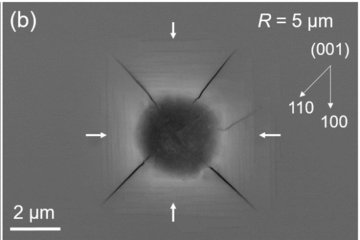All genres
21.
Journal Article
Al–Mo–Ti Ternary Phase Diagram Evaluation. MSI Eureka, 10.17143.3.2 , pp. 1 - 47 (2021)
22.
Journal Article
Laves phases: a review of their functional and structural applications and an improved fundamental understanding of stability and properties. Journal of Materials Science 56, pp. 5321 - 5427 (2021)
23.
Journal Article
Crystal structure and composition dependence of mechanical properties of single-crystalline NbCo2 Laves phase. Acta Materialia 184, pp. 151 - 163 (2020)
24.
Journal Article
Atomic scale configuration of planar defects in the Nb-rich C14 Laves phase NbFe2. Acta Materialia 183, pp. 362 - 376 (2020)
25.
Journal Article
Effect of Oxygen on High‐temperature Phase Equilibria in Ternary Ti‐Al‐Nb Alloys. Zeitschrift für anorganische und allgemeine Chemie 646 (14), pp. 1151 - 1156 (2020)
26.
Journal Article
Composition dependence of hardness and elastic modulus of the cubic and hexagonal NbCo2 Laves phase polytypes studied by nanoindentation. Journal of Materials Research 35 (2), pp. 185 - 195 (2020)
27.
Journal Article
The Co–Ti system revisited: About the cubic-to-hexagonal Laves phase transformation and other controversial features of the phase diagram. Calphad 67, 101681 (2019)
28.
Journal Article
Iron Aluminides. Annual Review of Materials Research 49, pp. 297 - 326 (2019)
29.
Journal Article
In-situ investigation of phase transformations during heating of AlCoCrCuNi high entropy melt-spun ribbons. Materials Characterization 148, pp. 134 - 141 (2019)
30.
Journal Article
Elemental partitioning and site-occupancy in γ/γ′ forming Co–Ti–Mo and Co–Ti–Cr alloys. Scripta Materialia 154, pp. 159 - 162 (2018)
31.
Journal Article
Microstructural and mechanical characterization of an equiatomic YGdTbDyHo high entropy alloy with hexagonal close-packed structure. Acta Materialia 156, pp. 86 - 96 (2018)
32.
Journal Article
Influence of composition and crystal structure on the fracture toughness of NbCo2 Laves phase studied by micro-cantilever bending tests. Materials and Design 145, pp. 116 - 121 (2018)
33.
Journal Article
Nb-Based Nb–Al–Fe Alloys: Solidification Behavior and High-Temperature Phase Equilibria. Metallurgical and Materials Transactions A 49 (3), pp. 752 - 762 (2018)
34.
Journal Article
Creep of Binary Fe–Al Alloys with Ultrafine Lamellar Microstructures. Intermetallics 90, pp. 180 - 187 (2017)
35.
Journal Article
The Effect of the Ternary Elements B, Ti, Cr, Cu, and Mo on Fully Lamellar FeAl + FeAl2 Alloys. Journal of Alloys and Compounds 722, pp. 219 - 228 (2017)
36.
Journal Article
Thermodynamic Assessment of the Fe–Al–Nb System with Updated Fe–Nb Description. Journal of Phase Equilibra and Diffusion 38 (5), pp. 771 - 787 (2017)
37.
Journal Article
Computationally-driven engineering of sublattice ordering in a hexagonal AlHfScTiZr high entropy alloy. Scientific Reports 7, 2209 (2017)
38.
Journal Article
Entwicklung intermetallischer Eisenaluminid-Legierungen. Stahl und Eisen 137 (5), p. 76 - 76 (2017)
39.
Journal Article
Coarsening Kinetics of Lamellar Microstructures: Experiments and Simulations on a Fully-Lamellar Fe–Al in situ Composite. Acta Materialia 127, pp. 230 - 243 (2017)
40.
Journal Article
The Al-Rich Part of the Fe–Al Phase Diagram. Journal of Phase Equilibra and Diffusion 37 (2), pp. 162 - 173 (2016)











